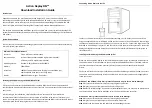
MFJ-495 Memory Keyer
Instruction Manual
©
2001-2009 MFJ Enterprises, Inc.
37
Preparing Messages
To prepare messages, use an ASCII text editor on your computer. Valid characters for messages include
all those listed in the chart “Morse Code Character Set” on page 45, the space, tab and carriage return. In
addition, there are special characters, shown in the table below. Any invalid characters in a message will
be ignored when the file is downloaded.
Special Characters
Characters
Represent
Square Brackets ( [ ] )
Delimiters for messages in memory.
Angle Brackets ( < > )
Delimiters for custom prosigns.
Back Slashes ( \ \ )
Delimiters for custom prosigns.
Space+Slash ( / )
Prefix for embedded commands.
Note:
The Tab is displayed as a right arrow character and the Carriage Return is displayed as a left
arrow character on the LCD. Both are sent as a word space.
You may control the unit's features during message playback by using embedded commands. These
embedded commands can set sending speed, audio tone, and Farnsworth values, as well as provide great
flexibility by allowing functions such as message looping and one message calling another. Embedded
commands begin with a slash “/” and must enter as a separate word. Upper or lowercase letters may be
used; embedded commands are not case-sensitive.
When a parameter such as Overall Speed or Tone is specified by an embedded command, the parameter
will remain set during playback of that message. When playback of that message is completed or
stopped, the value of the parameter will revert to the value set prior to the message playback.
Note:
Adjusting the Speed control during message playback will undo the settings set by embedded
commands /S, /U, /V and /W.
Embedded Commands
While in the message recording mode you may use embedded commands for special features. To use an
embedded command, simply store the multi-character embedded command code within your message.
To distinguish embedded commands from normal text, the embedded commands must be entered as a
separate word; that is, it must be preceded by a word space (this leading space is ignored during
playback). When encountered during message playback, the commands are executed. Note that if “/” is
part of a single word, as in K5MFJ/4, it is sent as expected and is not executed as an embedded command.
To use an embedded command at the beginning of a message, the space preceding the “/” is optional; that
is, “/” (without being preceded by a word space) at the beginning of a message is executed as an
embedded command. Embedded commands that are
not
at the beginning of a message must be prefixed
by “space + slash”. Embedded commands and their uses are explained below:
//
Slash – sends a slash character (dah-di-di-dah-dit) at the beginning of a message or
immediately after a word space.
/#
#
C
all – calls message #
#
, where the first
#
is a single digit in the range of 1 to 8 for the
message number and the second # is a letter in the range of A to D for the memory bank.
















































